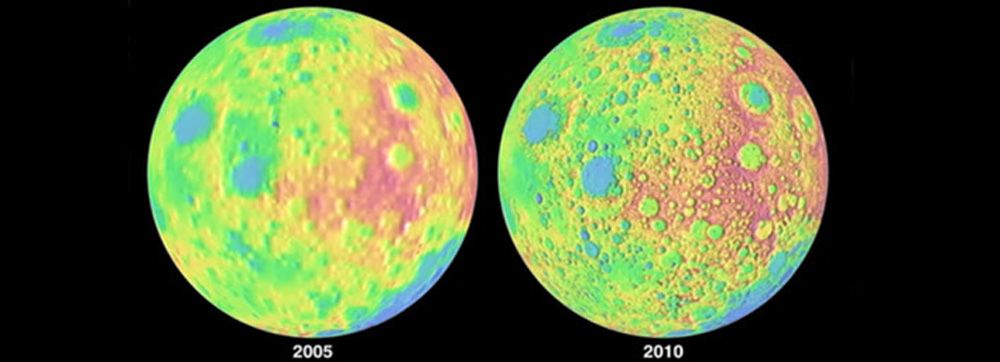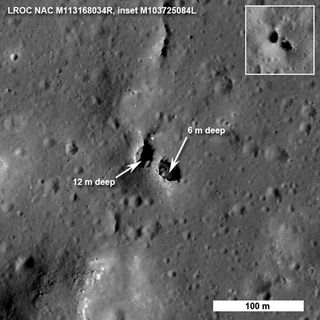
A spacecraft that mapped the lunar surface in unprecedented detail has been declared a resounding success, one that "forever changed our view of the moon," NASA announced today (June 21).
NASA's Lunar Reconnaissance Orbiter (LRO) has sent back to Earth enough information on the moon to fill 41,000 DVDs and is still going strong, taking photos and topographic measurements as it cruises just 30 miles (50 kilometers) above the lunar surface.
LRO launched in June 2009 with two main goals. In the probe's first year, NASA used it to scout the lunar surface for future exploration missions. In year two, the spacecraft shifted into a general science mode to investigate some of the lasting mysteries of the moon.
Every photo, map and other observation made by LRO during its first year has been beamed to Earth and compiled in a database, allowing mission scientists to declare the initial exploration phase complete. Researchers around the world can now access this vast storehouse of information, they said. [Moon Photos from NASA's LRO]
"LRO was originally conceived to deliver the kinds of information that we need to plan for safe and effective exploration of our moon," Michael Wargo, chief lunar scientist for exploration at NASA headquarters, told reporters. "Today we're here to tell you that that's exactly what we did, in spades."
The moon comes into focus
The $540 million spacecraft performed a data dump of epic proportions. It delivered some 192 terabytes of information, gathered during LRO's first year, to NASA's Planetary Data System. That’s more data than is stored in all the printed materials at the Library of Congress, officials said. [LRO's Coolest Moon Discoveries]
Sign up for the Live Science daily newsletter now
Get the world’s most fascinating discoveries delivered straight to your inbox.
LRO uses seven instruments to study the moon. Two of the most prolific tools have been its laser altimeter, known as LOLA, and its LROC camera system.
The LROC camera has helped scientists stitch together an incredibly detailed photographic mosaic of Earth's nearest neighbor. This global map, which was unveiled in March, covers the moon from pole to pole with a resolution of 328 feet (100 meters) per pixel.

LROC also has two higher-resolution cameras, which have photographed much of the lunar surface at 1.5 feet ( 0.5 m) per pixel. With such detailed views, researchers can see interesting features on the moon, such as odd natural bridges. And they can spot the marks that humanity has left behind.
"We can actually see where the [Apollo] astronauts walked, where they placed their scientific instruments and where they drove the rovers that they had taken with them," Wargo said.
LOLA, for its part, has been mapping out the topography of the lunar surface. To date, it's made more than 4.1 billion measurements. Previous spacecraft combined had taken about 8 million such readings at the moon, officials said.
LOLA's measurements have allowed scientists to make the best topographic map of the moon ever constructed, revealing key details that could aid future exploration efforts. For example, the readings have identified places that receive sunlight more than 240 days per year, suggesting they might be good places to set up solar-powered bases, researchers said.
Aiding future exploration
Sunlight is a key potential resource on the moon, as is water. Water not only would help keep moon settlers alive, it could be converted into rocket fuel, researchers have said.
In the last few years, researchers have come to realize that huge amounts of water likely exist on the moon, much of it trapped in the frigid depths of permanently shadowed craters near the poles. Several spacecraft have been key in this revelation, and LRO is one of them.
When LRO launched, it carried a piggyback probe called LCROSS. LCROSS was sent crashing into a shadowed crater at the moon's south pole four months later. The plume from the impact helped LRO confirm the presence of ice, and the probe's instruments have continued scanning for the stuff ever since.
"Whereas once we thought that the moon was bone-dry, we now know that it is indeed wet — wet enough to potentially provide water to future explorers," Wargo said.
Though the recent cancellation of NASA's moon-oriented Constellation program shifted the agency's immediate exploration focus away from Earth's only natural satellite, LRO's information could still be useful, officials said.
"We haven't ruled out the moon forever," said Doug Cooke, associate administrator for NASA's Exploration Systems Mission Directorate in Washington, D.C. "It is still a destination of interest in the future for humans."
Still studying the moon
The car-size LRO transitioned into its general science mission in September 2010, and it's funded to keep gathering information during this phase through at least September 2012, officials said.
LRO scientists plan to petition NASA for more funding next winter, to keep the probe going through September 2014. They say the spacecraft could operate even further into the future if it received enough money.
At the end of this year, mission scientists plan to take LRO to a more elliptical orbit, which should increase the probe's operational life; its current low-altitude orbit consumes lots of fuel, requiring frequent burns to avoid crashing into the lunar surface, officials said.
"NASA headquarters will continually, then, evaluate how well the instrument and spacecraft are performing, and then decide whether to fund us for time periods beyond 2012 or 2014," said Richard Vondrak, LRO project scientist at NASA's Goddard Space Flight Center.
This story was provided by SPACE.com, a sister site to LiveScience. You can follow SPACE.com senior writer Mike Wall on Twitter: @michaeldwall. Follow SPACE.com for the latest in space science and exploration news on Twitter @Spacedotcom and on Facebook.













